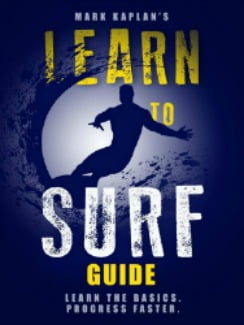Beginner Surfers Ride Real Waves
Beginner surfers ride real waves after they have successfully learned to catch and ride foam waves. There are differences between the two that require new skills.
After surfers have learned to ride foam waves to the beach, they can learn to paddle out and turn around to catch bigger foam waves. This teaches them to be moving to catch waves and works on timing.
How Real Waves Break
Foam waves are easy to catch because you just get in front of them. Real waves peak for a few seconds and you have to intersect them at the right point.
I teach beginners after they have learned to turn around and catch foam waves to start paddling parallel to where the waves are breaking. A real wave can be ridden down the face or can be caught at the corners.
Beginners should start with riding small real waves when riding down the face. They might form anywhere on a sand bar bottom. On reefs, they always break in the same place.
To catch a corner, the surfer notices where waves are forming and then where the apex (where foam first comes over the lip) is occurring. He wants to paddle towards the unfurling pocket and then point at 45 degrees toward the beach and let the pocket come under the board.
On a real wave face, the surfer notices where the wave is forming and makes a determination whether he has to paddle out, parallel, or toward shore to get in position for the arc. In foam waves, you let the foam hit the board. With a real wave, you have to get in front of the arc and paddle fast so that he wave is caught in the arc and not after it has broken.
This requires practice. There will be many crashes. Beginners often let the wave roll past them and then try to catch up and drop in over the top. This is not a successful practice. You have to be in front of the wave and let it catch up with the board.
The tail of the surf board will rise in the arc and the surfer paddles hard three times and even kicks. Then he executes the pop up and rides down the face.
Advanced surfers will learn to make a bottom turn on the face to ride the pocket and perform more maneuvers.
Learn More
For Oceanside Surf Lessons, see the Home Page
See the Post Surf Lessons Begin with Foam Waves
See the Post What You Learn in a 2 Hour Lesson
See the Post How to Progress in Surfing
See My Dry Land and In Water Demo video
See How to Catch a Green/Real Wave video
i have lowered my book and course prices for the lock down.
My New Surfing Course in an E-Book plus Demo Video
Get the 18 Chapter, 7,500 word Course that can prepare you for a lesson or give you the fundamentals if you are going to try it on your own. 10 years of teaching 350 students a year has given me the insights on the most precise measures you must follow for success. This course is what I teach on the dry land and in water instruction. The Course includes a 15 minute video on my dry land and in water demonstration. Only $4.95
Buy the E-book for $2.99. Learn to Surf (Different cover but same book)
Buy the Paperback on Amazon $6.95
Get Learn to Surf Course in 29 minute audio. Great prep for a lesson, reviewing after a lesson, learning on your own, refreshing after not having surfed for a while. See Table of Contents. Only $7.95

80 page Learn to Surf Book
![Surf Instructions Beginner to Advanced: Learn to Ride Waves by [Kaplan, Mark]](https://images-na.ssl-images-amazon.com/images/I/51HswFtoBQL.jpg)
Buy my E-book on Amazon Kindle for $2.99. 80 pages of beginner to advanced instructions to help you before the first lesson to learning expert techniques and tricks.
I also have books on Creating Your Own Happiness on a site called Happiness and Work Life Balance